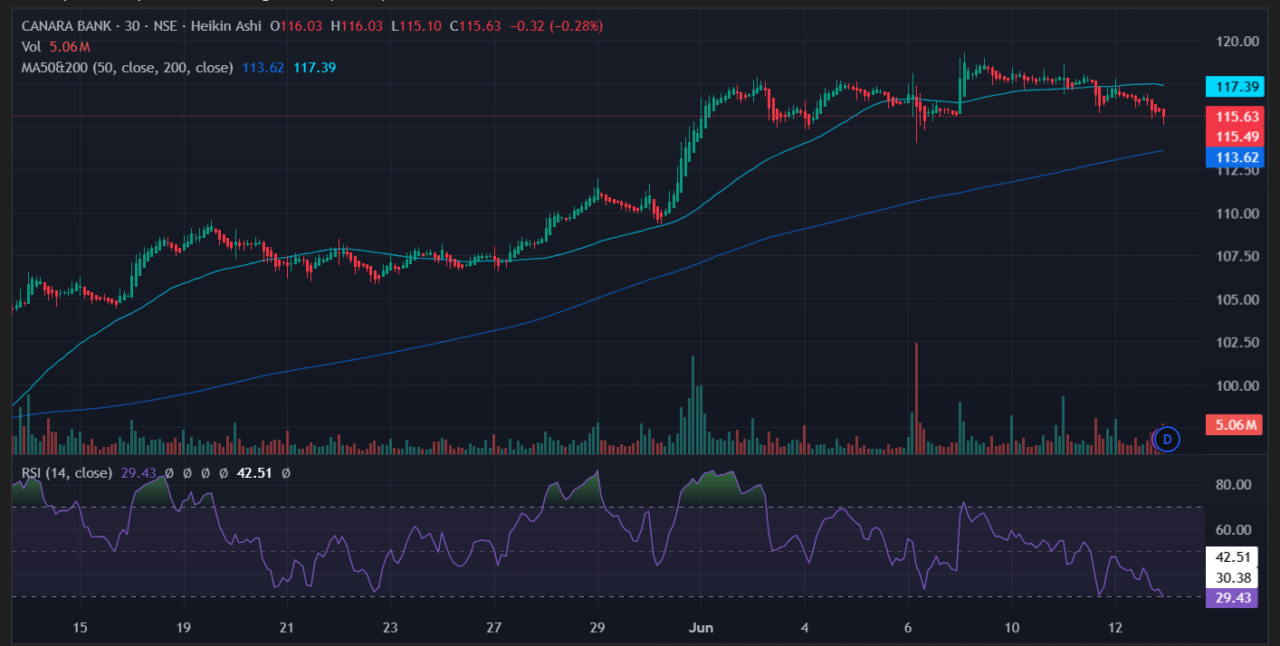Canara Bank Share Price: Canara Bank plans to raise ₹9,500 crore through debt instruments this fiscal year, following a strong dividend payout. Is this a sign of more growth to come?

Canara Bank Fundraise: ₹9,500 Cr Debt Plan Gets Board Nod
In a bold capital move for FY2025-26, Canara Bank has received board approval to raise up to ₹9,500 crore via Basel III-compliant debt instruments. This announcement comes shortly after the PSU bank declared a 200% dividend payout, signaling strong fundamentals and aggressive future plans. However, the Canara Bank share price closed down by 1.20% to ₹115.70 per share on June 12, despite the upbeat news.
Capital Raise Breakdown: AT1 and Tier II Bonds in Focus
On Thursday, Canara Bank filed with the BSE, stating that its board has approved the capital raising plan of ₹9,500 crore through a mix of Additional Tier I (AT1) and Tier II bonds, both compliant with Basel III norms.
-
₹3,500 crore is earmarked for AT1 bonds, known for absorbing losses in times of stress.
-
₹6,000 crore will be raised via Tier II bonds, which bolster the bank’s overall capital adequacy ratio.
According to the regulatory note, the actual issuance will depend on market conditions and regulatory approvals, suggesting a staggered approach to fundraising over the coming quarters.
Canara Bank Share Price: Mixed Reactions

Despite the capital infusion plan, Canara Bank share price closed in the red at ₹115.70, down 1.20% from the previous close. From technical point of view, the Canara Bank share price crossed down the SMA (200) & the RSI is approaching towards lower levels of 30.
Here’s how the stock has performed:
-
This week: Down 1.2%
-
Last month: +14.77%
-
Last three months: +40.33%
-
Last 5 years: Massive +457.59% return
The dip could be attributed to profit booking, as the stock has rallied significantly in recent months.
Also Read: Aditya Birla Capital Share Price: Stake Sale Worth ₹568 Cr Triggers Sharp Market Reaction
Investor Sentiment: Strength or Dilution Risk?
Many analysts are divided on the implications of this large-scale capital raise.
However, retail investors remain cautious about potential dilution risks, especially from AT1 bonds, which carry higher risk during financial distress.
Notably, Canara Bank has been aggressively expanding its retail and MSME loan book, which has shown double-digit growth over the last two quarters. The capital raise could therefore act as fuel for credit growth and risk absorption, vital in a rising interest rate environment.
Peer Comparison: Is Canara Bank Playing Catch-Up?
Several large PSU banks, including SBI and Bank of Baroda, have also raised capital through similar instruments in FY24. Canara Bank’s move is aligned with industry trends as PSU banks bolster capital to maintain competitiveness and support growth.
Compared to peers:
-
SBI raised ₹10,000 crore last year through Tier II bonds.
-
BOB announced a ₹7,500 crore fundraising earlier this year.
This trend reflects the system-wide push for stronger capital buffers, especially ahead of expected credit growth in FY26.
What to Expect Next: Outlook for FY26
With this capital buffer, Canara Bank is likely to:
-
Support higher credit expansion
-
Improve capital adequacy ratios
-
Weather any macroeconomic headwinds
Many analysts suggest that if market conditions remain stable, the first tranche of bond issuance could happen in Q2 or Q3 of FY26. For investors, the key will be to watch how cost of borrowing and interest margins evolve post-issuance.
Conclusion: Cautious Optimism for Investors
To sum up, Canara Bank’s ₹9,500 crore fundraising plan is a strategic step toward long-term stability and growth. While the short-term stock dip may concern some, the underlying fundamentals remain robust, backed by dividend payouts and historical price performance.
For investors, this could be an opportunity to accumulate on dips, especially if bond issuance improves the bank’s capital metrics without significantly impacting returns. As always, monitor execution timelines and macro indicators before making investment decisions.
Disclaimer: The views and investment insights provided here are based on publicly available information and do not constitute financial advice. Readers are advised to conduct their own research or consult certified financial experts before making investment decisions.
